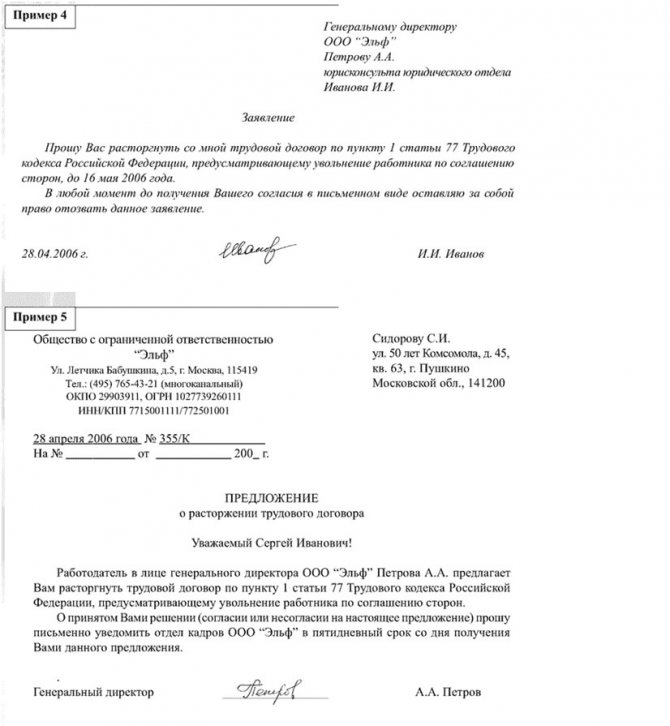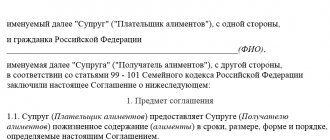From time to time, events at an enterprise develop in such a way that dismissal, either at the initiative of the employer or the employee, does not seem beneficial to anyone. Then an agreement is drawn up to terminate the employment agreement (contract) by agreement of the parties.
Why is this beneficial for a company or organization:
- there is no need to coordinate dismissal with the trade union;
- the possibility of terminating the employment relationship while the employee is on vacation or during a period of incapacity;
- this basis allows you to terminate the student contract.
Advantages of this termination for the employee:
- continuous work experience until employment is maintained for up to 1 month;
- When registering with the employment service, payments are assigned in a larger amount for a period of up to 3 months.
Labor legislation
Termination of an employment contract by agreement of the parties is regulated by clause 1 of Art. 77 of the Labor Code of Russia (LC RF), it recognizes the agreement as one of the general grounds. It is necessary to emphasize that in Art. 78 of the Labor Code of the Russian Federation, the legislator also clarifies: an employment contract can be terminated at any time by agreement of the parties. Agreement between the parties is an independent prerequisite for the annulment of an employment contract. Undoubtedly, it is worth mentioning that its implementation requires mutual consent of the parties to the labor relationship.
Consequences of changing the contract
It is important to know that when the contract is amended, it will change in those parts that are specified in the agreement itself or by a court decision:
- When the contract has been amended in one of the following ways, either extrajudicially or in court, the obligations remain in the amended form.
- Changes to the essential terms of the contract come into force after the parties sign the agreement or after the court decision enters into legal force.
- The parties cannot demand the return of what was previously before the agreement or court decision.
- When changing the contract, if the initiator was a party whose rights were violated by the essential terms of the contract, then it has the right to demand compensation for losses from the other party.
Also, as concerns paragraph 4 of this section, we can highlight the procedure for collecting penalties under the contract; this applies to when a party violated the deadline specified in the contract, which is an essential condition.
Why is an agreement needed?
Termination of an employment contract by agreement of the parties is an opportunity to terminate the employment relationship on very favorable terms for the parties, taking into account all aspects that were missed in the text of the employment contract and the Labor Code. The contents of the agreement should also not contradict current legislation.
All aspects should be discussed in detail, for example:
- payment of compensation upon dismissal, establish a certain amount or number of salaries;
- the employee’s last working day (according to current legislation, the employee must work 14 days, but in this case the terms can be either reduced or, therefore, increased);
- return of all corporate funds to the company funds, if any were used by the employee,
- provision of leave before dismissal or compensation payments for it, etc.
Also, a written agreement can serve as a guarantee that all obligations of the parties will be fulfilled upon termination of the employment relationship. This agreement can be terminated only with the consent of both the employer and the employee; it is unrealistic to do this unilaterally.
Highlights of the cooperation agreement
The standard form of an agreement on cooperation and joint activities must include the following:
- The parties act in joint interests without forming a legal entity (Civil Code of the Russian Federation, Article 1041, paragraph 1);
- The agreement must indicate the numbers of the Unified State Register of Individual Entrepreneurs/Unified State Register of Legal Entities and the passport details of the responsible persons, since the document presupposes an agreement between legal entities (Civil Code of the Russian Federation, Article 1041, paragraph 2);
- It is necessary to indicate the amount of investment or contribution to each of the participants;
- Subject of the agreement. These may be services providing legal, technical assistance, etc. (Article 1042, paragraph 1);
- Drawing up an agreement on cooperation and joint activities involves indicating the boundaries of the use of trade secrets by each party.
IMPORTANT! When filling out the form, in the paragraph on the responsibility of the parties and the resolution of disputes, it is necessary to indicate not only the arbitration court, but also the court of general jurisdiction.
Compensation payments upon dismissal by agreement of the parties
In Art. 178 of the Labor Code of the Russian Federation, the legislator does not indicate the requirement to pay compensation upon dismissal by agreement of the parties, but he says that in the employment contract the parties have the right to additionally prescribe other types of payments and benefits, as well as their amount. I would really like to emphasize that if this type of compensation is not specified in the employment contract, it must certainly be included in the clauses of the agreement.
Accordingly, upon dismissal by agreement of the parties, the employer’s responsibility includes the following payments:
- wages for the period worked (including all allowances and bonuses, if any);
- compensation for unused vacation or vacation pay when provided.
Compensation payments upon termination of an employment contract by agreement of the parties do not apply to mandatory payments.
When is it possible to change the terms of the contract?
Currently, this is permissible only under certain and serious grounds, for which the following conditions must be present:
- the partners did not anticipate that any changes would occur;
- the parties to the agreement failed to cope with the reasons that led to the current situation;
- fulfillment of the agreement may entail that one of the parties will lose what they were counting on;
- such a risk was not provided for in the original document;
- other cases when it is impossible to do without changing the terms of the contract.
One of the participants has the right to change the terms of the agreement in cases where:
- significant violations of the obligations of one of the parties;
- by mutual agreement.
The question of whether the contract can be changed is quite relevant. To resolve this issue, you will need to conduct a legal analysis of the current contract and decide what changes would be beneficial to make to it:
Procedure for terminating an employment contract by agreement of the parties
- The agreement between the parties to the employment relationship is drawn up in writing, the subject of which is precisely the termination of the employment contract. This agreement may be preceded by a written statement with the initiative of both the employer and the employee, although this action is not mandatory.
- The enterprise issues an order from the manager regarding dismissal from office.
- The employee must be familiarized with the dismissal order against signature. Otherwise, this agreement may be declared invalid. This is also required by Art. 84.1. Labor Code of the Russian Federation and clause 7 of Art. 9 of the Federal Law “On Accounting”, because this document is the basis for stopping the payment of wages.
- The employer issues the employee a work book, which must contain a record of dismissal with reference to the relevant norm of labor legislation. The wording should not have any ambiguous meaning, otherwise it may be grounds for litigation. The employee must put his signature in the work book, if he agrees with this wording, also in the work book movement journal and personal card.
- If, for any reason, it is not possible to hand over the work book to an employee, you need to send him a notice to the address of his place of registration and residence. In it, inform that he must appear to receive the work book or agree to send it by mail. Please note that in this order, liability for the delay in issuing the work book in accordance with Art. 84.1 of the Labor Code of the Russian Federation is removed from the employer.
- All payments must be paid to the employee on the last working day. If an employee is absent, all payments must be provided to him upon request no later than the next day from the moment he appears in the company.
A little history
It’s worth starting from the roots, namely, with Roman law, which underlies the modern Romano-Germanic legal system. Contracts in Roman law were the most general concept and were divided into contracts (contractus) and pacts (pactum).
A contract meant an enforceable agreement between the parties. Pacts, as a general rule, recognized agreements that were deprived of enforceable protection, although over time some pacts still received it.
Important: The concept of enforceability is inextricably linked with the category of claim protection. Enforceability is a tool by which any party whose rights and interests under a contract have been violated can seek protection in court. Without enforceability, a contract becomes an ordinary agreement, where everything is built on the trust of the parties and is not supported by anything solid. And in case of fraud, the contract without legal protection turns into thin air.
It is important to emphasize that writing was not mandatory for contracts in Roman law. Among the contracts, in addition to other types, there were literal contracts (concluded in writing) and verbal contracts (acquired legal force at the moment the necessary words were spoken orally).
The most important subtype of verbal contracts was recognized as the so-called stipulation - an oral contract that acquired legal force from the moment phrases in the style were uttered
- “Do you promise to pay the amount N?”
- “I promise to pay the amount N.”
The question and answer in the stipulation had to completely coincide in meaning, and the entire stipulation procedure was riddled with formalities. Without compliance with formalities, an oral contract in the form of a stipulation was considered not concluded.
Interesting: During the classical period, a written form of stipulation also appeared, and the formal requirements became less strict.
Taking the concept of Roman law as a basis, many countries began to separate agreements and contracts as independent terms with their inherent legal features. Where an agreement is a mutual agreement between the parties, built on a trusting relationship in the fulfillment of their obligations. A contract is an agreement in writing between two or more parties that creates mutual obligations and is enforceable.
How is an agreement concluded?
Labor law does not provide a form of agreement. But, based on Art. 67 of the Labor Code of the Russian Federation, the employment contract is concluded in writing in 2 copies. The optimal solution would be to formalize the termination of this contract using a similar method. Therefore, it is also better to draw up the agreement in writing, in 2 copies, one of which remains with the employer, the second - with the employee. It is imperative to indicate in the agreement that each party has a copy.
Naturally, an agreement can be concluded orally, but in this case it will not be difficult for the parties to break the agreement. It will be very difficult to prove violations of your own rights in a labor commission or court.
A written agreement will guarantee the exact fulfillment of obligations, as well as the basis for restoring one’s own rights in a labor dispute.
Types of agreements
An agreement can be drawn up in a variety of circumstances. It is concluded both between large enterprises and between ordinary citizens.
Alimony agreement
Divorcing parents can agree on the amount and procedure for child payments. In this case, an alimony agreement is drawn up. The document contains these provisions:
- City of composition.
- Information about the recipient and payer of alimony: full name, series and passport number.
- The child's full name and birth certificate number.
After the preamble comes the text of the document itself. It includes these items:
- Validity period of the document.
- Amount of alimony.
- Number of payments.
- Bank details.
The agreement may stipulate additional payments due under special circumstances: children traveling on vacation, treatment. The rights and responsibilities of parents must also be indicated in the document. The alimony agreement is drawn up in 3 copies. Two remain with each parent, one is given to the notary.
FOR YOUR INFORMATION! An alimony agreement solves a number of problems. It records the agreement of the parents and is a guarantee of payment of money. If one party violates its obligations, the other party may go to court. The agreement confirms the existence of contractual obligations. It must be attached to the statement of claim.
Indemnity Agreement
Compensation is paid when one person causes damage to another. A similar situation can arise, for example, in the event of an accident, flooding of neighbors, or a fire with the presence of a person at fault. An agreement is a document reflecting the obligations incurred by the perpetrator. It determines the amount of compensation and fixes the date of payment of funds.
IMPORTANT! The indemnity agreement must be registered with a notary.
Tripartite Agreement
Typically, an agreement is concluded between two parties. However, it can also be tripartite. This document is relevant in the following situations:
- Sublease of premises . The parties to the agreement will be the owner of the premises, the tenant and the head of the company.
- Electricity supply . The parties to the agreement will be the electricity supplier, its consumer and the company organizing the supply of the resource.
The document is drawn up in a standard manner. But there are some nuances. In particular, the agreement must have 3 signatures, corresponding to the number of participants in the transaction. Until there are 3 signatures on the document, it will not be valid.
What should the agreement look like?
There is no fixed form of the agreement, so it can be drawn up in any form. However, you need to adhere to certain rules and mandatory points:
- The date of dismissal is the last working day, if the employee takes vacation before dismissal, this is considered the last day of vacation.
- A note that the termination of the employment contract occurs by mutual consent of the parties.
- All the points described in the section “Why is an agreement needed?” , as well as other agreements of some other kind between the employer and employee related to the dismissal procedure.
- Personal signature of the employer and employee under all terms of the agreement;
If any of these points are missing, the agreement may be declared invalid.
Amount of compensation in 2015
As mentioned earlier, the legislator left this type of compensation for consideration by the employer and employee, therefore the amount of compensation can be any. Of course, everything depends on the agreement of the parties.
Sample


Dismissal by agreement of the parties without payment of compensation
If compensation payments upon termination of an employment contract by agreement of the parties are not provided for in its clauses, as well as in the text of the agreement, or the agreement is concluded orally, the employer may evade payment of compensation.
You need to be very careful when terminating a contract by agreement of the parties. It's no secret that when the initiator is the employer, he may be trying to avoid additional payments, for example, payments to an employee who is drafted into the army. Undoubtedly, it is worth mentioning that if the initiator is an employee, for example, he could cause material harm to the enterprise and is trying to evade responsibility by terminating the employment contract. Before an agreement, all facts must be carefully checked.
The legislator does not prohibit the dismissal of a pregnant woman by agreement of the parties. However, if an employee applies for refusal of dismissal, the employer does not have the right to terminate the employment contract. I would really like to emphasize that labor legislation provides additional guarantees for pregnant women.
The procedure for changing the terms of agreements between participants
Any party can initiate a change in the terms of the contract; the legislator does not provide privileges for a specific party. In the process of changes to the contract, the following stages can be distinguished:
- The parties change the terms of the agreement through negotiations
- The parties must express their will
- Agree on will by exchanging wills
- And of course, formalize the expression of will by giving it a form
USEFUL: watch the video and you will find out why Clients choose our organization as their assistant, write your question in the comments of the video and receive FREE legal advice on any issue









